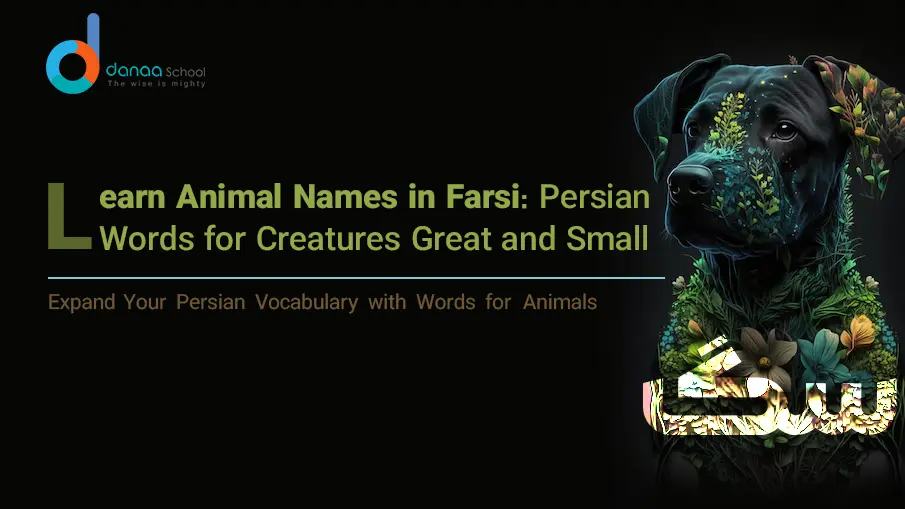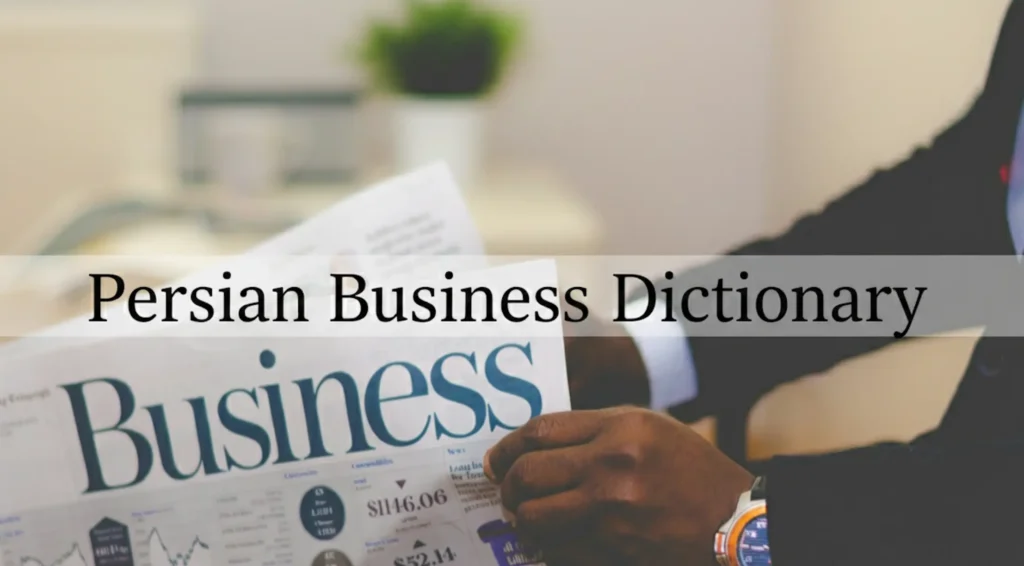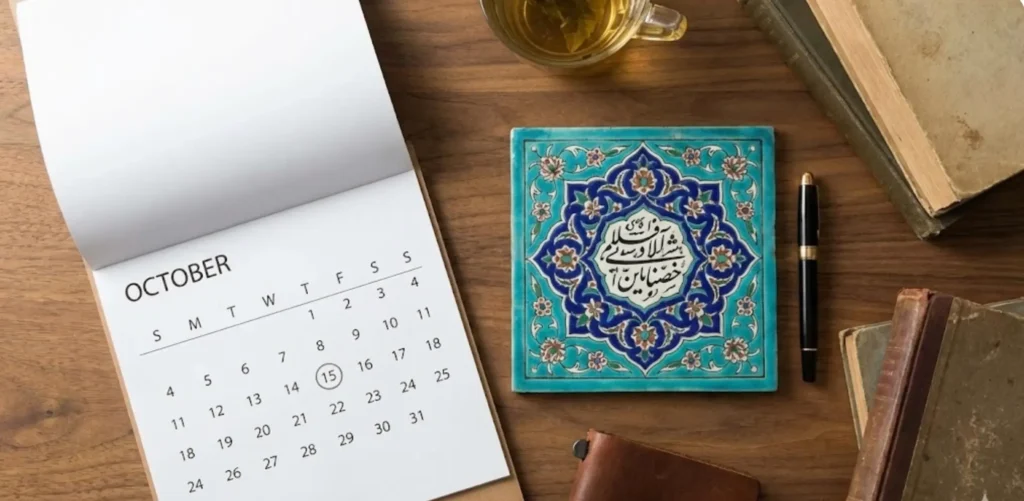Learning Persian, also known as Farsi, is a journey into a rich cultural and linguistic history. A fun and rewarding aspect of mastering any new language is learning its vocabulary. One of the easiest and most engaging ways to do this is by familiarizing yourself with the words for animals. Whether it’s for casual conversations, travel, or exploring Persian literature, having a grasp of animal names can make learning Persian more interactive and enjoyable.
This article will help you learn Persian vocabulary for animals, including domestic, wild, aquatic, and exotic creatures. Learning these names is not only practical but also a gateway to understanding Persian culture and the way nature and wildlife are perceived in everyday life.
Persian Vocabulary for Animals
Building a diverse animal vocabulary in Persian can help expand your conversational skills. Let’s explore the different categories of animals in Farsi, from domestic pets to exotic wildlife.
Common Domestic Animals in Persian
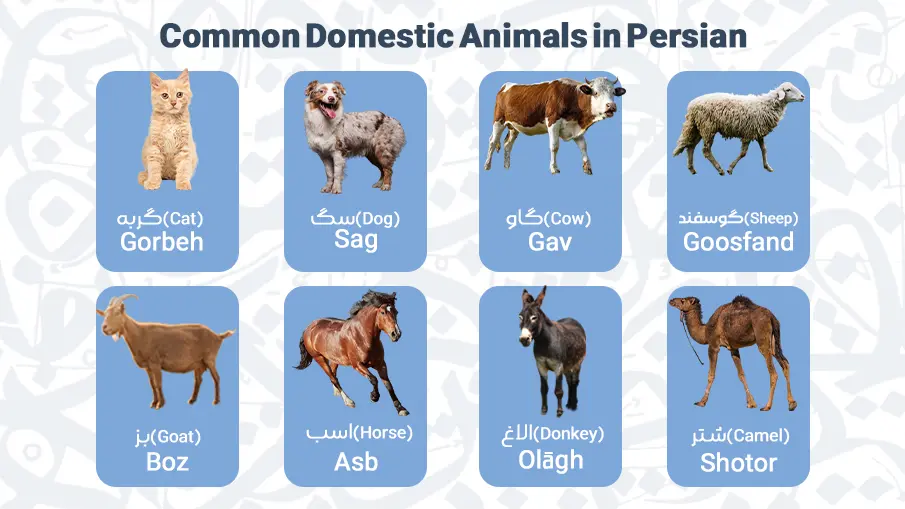
Persian culture has a deep connection with animals, particularly domestic ones, which have been part of Iranian life for centuries. Knowing these names will help you in everyday conversations, especially when visiting rural areas or speaking with animal lovers.
-
- Cat (گربه) – Gorbeh: Cats are quite common in Iran, and many households have them as pets.
-
- Dog (سگ) – Sag: Dogs, while less common as house pets, are important in rural and nomadic life.
-
- Cow (گاو) – Gāv: Cows are vital for their milk and meat, often seen in the countryside.
-
- Sheep (گوسفند) – Goosfand: A significant animal in rural communities, providing wool and meat.
-
- Goat (بز) – Boz: Like sheep, goats are crucial for their milk, meat, and even as companions.
-
- Horse (اسب) – Asb: Horses are revered, especially in traditional Persian culture.
-
- Donkey (الاغ) – Olāgh: Commonly used in rural areas for carrying goods and people.
-
- Camel (شتر) – Shotor: Essential in desert regions for transport and sustenance.
Additional Farm Animals
-
- Chicken (مرغ) – Morgh: Found in almost every Iranian village, providing eggs and meat.
-
- Rooster (خروس) – Khorus: The rooster’s crow is a familiar sound in Persian countryside settings.
-
- Duck (اردک) – Ordak: Ducks are raised for both eggs and meat in some rural parts of Iran.
-
- Turkey (بوقلمون) – Boqalemoon: Gaining popularity, especially around Persian holidays.
-
- Rabbit (خرگوش) – Khargush: Often kept as pets and occasionally raised for their fur and meat.
Learning these names will give you the ability to navigate rural markets, and farms, or even have casual chats about animals with native speakers.
Wild Animals in Persian
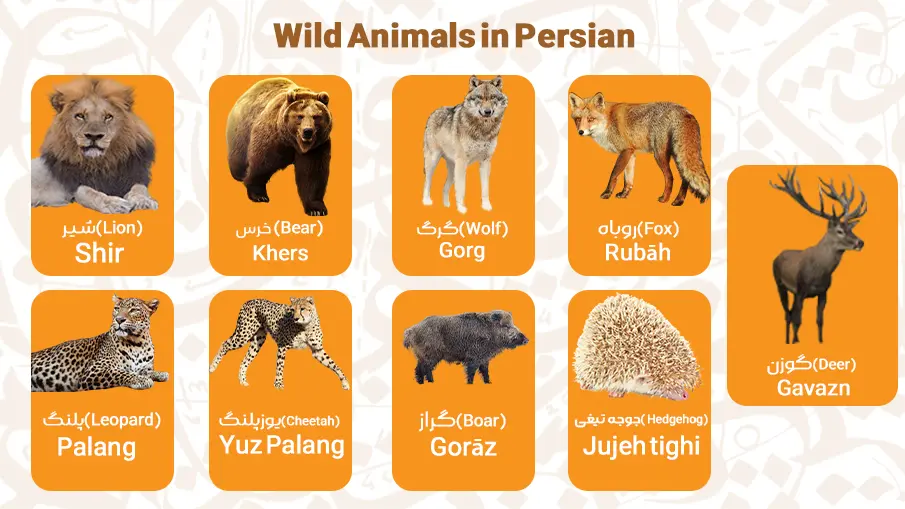
Iran is home to a vast array of wildlife, much of which holds cultural and historical significance. Learning the Persian names for wild animals not only helps expand your vocabulary but also allows you to appreciate the diversity of Iranian nature.
-
- Lion (شیر) – Shir: The lion is a symbol of courage and strength, deeply rooted in Persian history and mythology.
-
- Bear (خرس) – Khers: Found in the northern forests, particularly in the Alborz mountains.
-
- Wolf (گرگ) – Gorg: Wolves are respected animals in Persian folklore, symbolizing cunning and survival.
-
- Fox (روباه) – Rubāh: Frequently appears in Persian tales and poetry, representing cleverness.
-
- Leopard (پلنگ) – Palang: The Persian leopard is a majestic, endangered species living in the mountains.
-
- Cheetah (یوزپلنگ) – Yuz Palang: One of the fastest land animals, the Asiatic cheetah is critically endangered and native to Iran.
-
- Boar (گراز) – Gorāz: Wild boars roam the forests of northern Iran.
-
- Deer (گوزن) – Gavazn: Deer symbolize grace and beauty in Persian literature and are found in northern forests.
-
- Hedgehog (جوجه تیغی) – Jujeh tighi: Hedgehogs are common in rural and desert areas.
Learning these wild animal names will enrich your vocabulary, especially if you’re discussing Persian wildlife or visiting nature reserves in Iran.
Aquatic Animals in Persian
Iran has access to several water bodies, including the Caspian Sea, Persian Gulf, and various rivers, making aquatic life an important part of the natural landscape. Here are some common aquatic animals you’ll find in Persian:
-
- Fish (ماهی) – Māhi: A general term for fish, commonly consumed and found in markets.
-
- Shark (کوسه) – Kuseh: Sharks are found in the waters of the Persian Gulf.
-
- Dolphin (دلفین) – Dolphin: Dolphins are playful creatures often seen in the Persian Gulf.
-
- Whale (نهنگ) – Naheng: Whales occasionally pass through the Persian Gulf and are symbols of strength in Persian literature.
-
- Octopus (اختاپوس) – Akhtāpos: An octopus is known for its intelligence and appears in both the Persian Gulf and Caspian Sea.
-
- Crab (خرچنگ) – Kharchang: Crabs are commonly found along the shorelines and in markets.
-
- Turtle (لاکپشت) – Lākposht: Sea turtles can be seen on Iran’s southern coasts.
Knowing these names will help you explore aquatic environments, whether you’re at a Persian fish market or discussing marine life.
Insects and Small Creatures in Persian
Insects and small creatures are everywhere, and knowing their Persian names can help you in everyday conversation, especially when discussing nature or even agriculture.
-
- Ant (مورچه) – Murcheh: Ants are common in gardens and homes across Iran.
-
- Bee (زنبور) – Zanbur: Bees are highly valued for their honey production.
-
- Butterfly (پروانه) – Parvāneh: Butterflies are celebrated for their beauty and are often mentioned in Persian poetry.
-
- Spider (عنکبوت) – Ankabut: Found everywhere from homes to forests.
-
- Scorpion (عقرب) – Aghrab: Scorpions, particularly in the desert areas, are well-known in Iran.
-
- Mosquito (پشه) – Pasheh: Common in warm areas, especially near water sources.
-
- Fly (مگس) – Magas: A nuisance in many places, especially during the summer.
Understanding these smaller creatures is also useful if you’re spending time outdoors or talking about farming, pests, or gardening in Persian.
Exotic and Zoo Animals in Persian
While not native to Iran, these exotic animals are often found in zoos or mentioned in stories and travel experiences:
-
- Elephant (فیل) – Fil: Elephants are symbols of strength and wisdom, sometimes appearing in Persian tales.
-
- Giraffe (زرافه) – Zarāfeh: Giraffes, with their long necks, are often featured in Persian zoos.
-
- Kangaroo (کانگورو) – Kānguro: A curious animal from Australia, seen in zoos and discussed for its unique traits.
-
- Panda (پاندا) – Pāndā: Pandas are not native to Iran but are widely recognized and adored globally.
-
- Zebra (گورخر) – Gur Khar: Known for their striking stripes, zebras are commonly seen in zoos.
-
- Tiger (ببر) – Babr: Although no longer found in Iran, tigers were once a part of Persian wildlife and still appear in stories.
Knowing these animals helps when visiting a zoo or simply engaging in discussions about global wildlife and conservation in Persian.
Persian Animal Sounds: How Animals Speak in Farsi
It’s not just humans who speak different languages! In Persian, animals are described as making distinct sounds, and learning these onomatopoeic words can add depth to your understanding of both the language and the culture.
-
- Cat’s meow (میو میو) – Meyu meyu: The familiar sound of a cat.
-
- Dog’s bark (هاپ هاپ) – Hap hap: How dogs bark in Persian.
-
- Cow’s moo (ما ما) – Mā mā: The sound a cow makes.
-
- Sheep’s bleat (بع بع) – Ba’ ba’: The sound of a sheep or goat.
-
- Bird’s chirp (جیک جیک) – Jik jik: The sound of small birds, like sparrows.
These sounds, though simple, are essential for learning how Persians interpret animal behavior in daily conversation. Understanding these can make language learning more immersive and fun, especially if you’re reading Persian children’s books or engaging in light-hearted conversations.
Learning Persian with Danaa School
At Danaa School, the goal is to make learning Farsi both effective and enjoyable. By focusing on practical language usage, students can acquire the language more naturally. When it comes to learning Persian vocabulary for animals, Danaa School adopts an interactive method, using videos, games, and immersive activities to ensure that students retain what they learn.
Danaa School provides a curriculum that is tailored to different learning levels, making sure that beginners, intermediates, and advanced learners are all catered to. Their engaging lessons on animal vocabulary, for instance, allow learners to associate images and sounds with Persian words, making the learning process more intuitive.
With Danaa School’s approach, you will not only memorize the vocabulary but also gain the confidence to use these words in context, whether you’re visiting a zoo, watching a documentary, or simply having a casual conversation about animals in Persian.
Find Your Ideal Teacher
At Danaa School, you can choose your Farsi tutor from a selection of qualified and experienced teachers. Begin an exceptional journey into the world of Persian language!
Book Your Trial Lesson
Learn Persian Vocabulary for Animals with Confidence
Expanding your Persian vocabulary to include animals is not only fun but also useful for a variety of situations. Whether you’re interested in Persian culture, wildlife, or simply want to broaden your language skills, knowing these words will help you engage more fully in conversations and experiences.
By incorporating both common domestic animals and more exotic wildlife, you’ll be able to navigate a variety of topics with ease. Moreover, by understanding animal sounds in Persian, you can appreciate the playful side of the language and culture.
FAQs
How do you say lion in Persian?
The word for lion in Persian is Shir (شیر).
What’s the Persian word for wolf?
The Persian word for wolf is Gorg (گرگ).
How do you say elephant in Persian?
Elephant is called Fil (فیل) in Persian.
What is the Persian word for dolphin?
The Persian word for dolphin is Dolphin (دلفین).
How do you say butterfly in Persian?
The Persian word for butterfly is Parvāneh (پروانه).
What is the Persian word for spider?
The word for spider in Persian is Ankabut (عنکبوت).
Conclusion
Learning Persian vocabulary for animals is a great way to enhance your language skills and deepen your connection to both the language and the culture. From common pets and farm animals to wild creatures and aquatic life, knowing these words will give you a well-rounded vocabulary that can be applied in various settings.
Whether you’re planning a trip to Iran, want to converse with native speakers, or simply expand your linguistic knowledge, mastering these Persian animal names will bring you one step closer to fluency. Start your Farsi learning journey now.
Want to Learn Farsi at Danaa School?
Here are the best resources for you!



